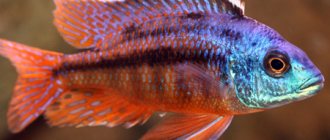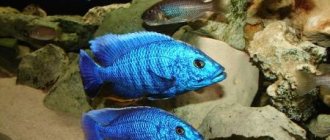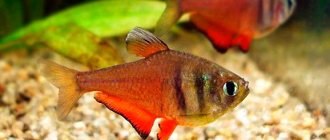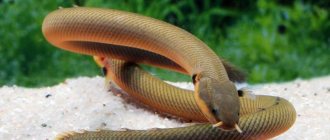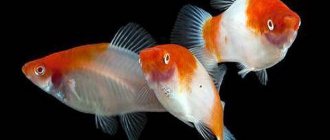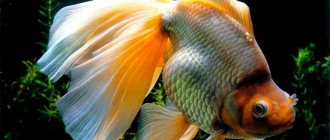Cornflower blue haplochromis (Sciaenochromis fryeri) is an aquarium fish of the cichlid family, which got its name for its juicy blue color and has been holding the attention of aquarists for many years. The species is distinguished by its rather moderate aggressiveness in comparison with its relatives - the cichlids of Lake Malawi, which does not negate its pronounced territoriality.
Currently, the Haplochromis fish has several related species, with which it is often confused. The most famous among them is Sciaenochromis ahli, with which cornflower blue is especially similar. They can be distinguished by the anal fin; in the cornflower blue it has a red edge, while in scyanochromis there are white spots on it. Also, adult cornflower cichlids are inferior in size to akhli, the maximum for them is 15-16 cm, while akhli reach 20 cm or more.
In adult fish, gender differences are pronounced. The main one is the rich blue color of the males. Females are more characteristic of gray, steel, silver color with a blue tint. However, among them sometimes there are very bright individuals, but the difference still remains significant. Also, in the species Haplochromis cornflower, the female is much smaller than the male. Unfortunately, during juvenile age it is much more difficult to distinguish males from females.
Cornflower cichlids have a fairly decent lifespan - up to 10 years in good conditions.
Habitat in nature
The fish was first classified by Koning in 1993, although discovered in 1935. It is endemic to Lake Malawi in Africa, found only in that lake, but widely distributed there.
They live on the border between rocky and sandy bottoms at depths of up to 25 meters. Predatory, they mainly feed on fry of Mbuna cichlids, but they also do not disdain other haplochromis.
During the hunt, they hide in caves and rocks, lying in wait for the prey.
Thanks to this, there was even a mistake, since it was first imported into the aquarium as Sciaenochromis ahli, but these are two different species of fish. It then went on to receive a couple more distinct names until it was named Sciaenochromis fryeri in 1993.
Cornflower blue haplochromis is one of four species of the genus Sciaenochromi, although it is also the most famous. It belongs to a species different from the mbuna, living in places where the rock bottom is mixed with sandy soil. Not as aggressive as the Mbuna, they are still territorial, preferring to stick to rocky areas where they can hide in caves.
What fish can Haplochromis be kept with?
It is better to keep Haplochromis in a species aquarium. Other species of haplochromis, as well as Mbuna cichlids, for example, labidochromis, labeotropheus, will be good neighbors. Aulonocaras will not be very good neighbors. Fights often occur between these species of cichlids.
Don't forget, everyone else who fits into the fish's mouth will be eaten. Therefore, small cichlids and fry should not be kept with adult fish. In order for an aquarium to have peace, it must have plenty of hiding places, but we must not forget about the presence of space for swimming.
Description
A classic elongated body for cichlids, which helps in hunting. Cornflowers grow up to 16 cm in length, sometimes a little more.
The average lifespan of these Malawian cichlids is 8-10 years.
All males are blue (cornflower blue), with 9-12 vertical stripes. The anal fin has a yellow, orange or red stripe. The southern population of haplochromis differs in that they have a white border on the dorsal fin, while the northern population does not have it.
However, it is no longer possible to find pure, natural colors in an aquarium. Females are silvery, although mature ones can have a blue tint.
Sexual differences in fish
It will not be difficult to distinguish a male from a female by eye. Male individuals have a bright dark purple color. They are slightly larger than females and have a bright orange lower fin.
Female representatives are characterized by a light silver color, which shimmers beautifully while moving.
Experienced owners of such fish advise keeping no more than 1 male for every 4-5 females. This is explained by the fact that males are very aggressive and often compete with each other for the right to dominance in the community, as well as for the right to be the first to fertilize the eggs.
Difficulty in content
A good choice for an aquarist who has decided to try to keep Africans. They are moderately aggressive cichlids, but certainly not suitable for a community aquarium.
Like other Malawians, clean water with stable parameters is important for cornflower blue haplochromis.
The fish is not difficult to keep, even for beginners. Silver females do not look very attractive, but cornflower blue males completely compensate for the plainness of the females.
In the aquarium they are moderately aggressive and predatory. They are easy to care for, but any fish they manage to swallow will meet an unenviable fate.
Sometimes the fish is confused with another species that is similar in color - Melanochromis johani. But, this is a completely different species, belonging to the Mbuna and much more aggressive.
It is also often called another species, Sciaenochromis ahli, but according to foreign sources these are still two different fish.
They are very similar in color, but the akhli is larger, reaching 20 cm or more. However, information on African cichlids is very contradictory and it is quite difficult to distinguish the truth.
What do cichlids look like?
So, haplochromis is a fish from the Cichlid family, genus ray-finned. Due to crossing with closely related cichlids, new hybrids appear, making the study of the group more difficult.
The body of haplochromis is elongated, the head is pointed, and the eyes are large. The length of adult individuals is 12-16 cm. The fins are bright and powerful. The anal fin is triangular in shape and has visible spots.
The color of the fish depends on the type of haplochromis. Among them there are yellow, blue, red and almost black. Males are brighter colored than females. During spawning, the color of the males becomes even brighter.
Feeding
Haplochromis Jackson is an omnivore, but in nature it mainly leads a predatory lifestyle. In an aquarium, he will eat any fish he can swallow.
It should be fed with high-quality artificial food for African cichlids, adding live food and shrimp meat, mussels or pieces of fish fillet.
The fry eat crushed flakes and pellets. They should be fed several times a day, in small portions, as they are prone to gluttony, which often leads to death.
All the differences in the appearance of Haplochromis
The fish has a bright blue warmth with several vertical stripes (the number ranges from nine to twelve, and is determined only by genes). It should be noted that males acquire their color in the first year of life. At the same time, male representatives have a stripe of the anal fin, distinguished by a yellow, reddish or orange color.
Female representatives of haplochromis have a silvery color, which turns out to be not so bright. However, as they mature, the color may become light blue. At the same time, the fry visually resemble females, but subsequently change.
The fish has an elongated body. Nature intended that such a body would help in successful hunting. The length can be about 16 centimeters. In some cases, this parameter turns out to be larger, but the difference is insignificant.
It is important to note that aquarium fish, unfortunately, almost never have pure colors due to natural characteristics.
Keeping in an aquarium
It is better to keep it in an aquarium of at least 200 liters, which is quite spacious and elongated.
The water in Lake Malawi is characterized by high hardness and stable parameters. To ensure the necessary cruelty (if you have soft water), you need to resort to tricks, for example, adding coral chips to the soil. Optimal parameters for keeping: water temperature 23-27 °C, pH: 6.0-7.8, 5 - 19 dGH.
In addition to hardness, they are also demanding on the purity of water and the low content of ammonia and nitrates in it. It is advisable to use a powerful external filter in the aquarium and regularly replace part of the water, while siphoning the bottom.
In nature, haplochromis live in places where there are both piles of stones and areas with a sandy bottom. In general, these are typical Malawians who need lots of shelter and rocks and have no need for plants at all.
To create a natural biotope, use sandstone, driftwood, stones and other decorative elements.
Maintenance and care
Conditions
The Cornflower cichlid is especially valued among beginners,
because it is quite simple in content. Please note that simple does not mean unpretentious and the basic requirements should be adhered to very strictly.
First of all, it is necessary to provide the Haplochromis fish with space; the volume of the aquarium for keeping them should be from 200 liters for 2-3 individuals and be much larger if you intend to add neighbors to them.
The second important factor for the comfortable well-being of fish is clean, well-aerated, warm water. Parameters: temperature – 24-27°C, hardness from 10 to 25°dH, acidity – 7-8.5pH. Having a good filter is a must. Water changes are carried out regularly once a week, approximately a third of the volume is replaced. The more aquarium fish you have and the smaller the size of the tank, the more often you need to replace the water with fresh water, since cornflower blue haplochromis is highly sensitive to the content of harmful substances.
Any soil for keeping haplochromis cichlids is allowed, the main thing is that it has no sharp edges, because these fish often like to rummage in it. Due to the fact that cichlids prefer hard water, it is allowed to use marble chips as soil in their aquariums, which increases hardness. Lighting should be
good and long lasting.
Plants are not necessary for this type of aquarium fish, and few of them will be able to thrive under these water parameters. But it is highly advisable to take care of artificial shelters, grottoes and other decorations. From time to time, females, tired of the attention of the male, are forced to take refuge in them.
Feeding
It is advisable to feed cornflower blue haplochromis with special food intended for the cichlid family. They do not disdain both live and frozen food. The main thing in this matter is to avoid overfeeding. These aquarium fish do not know limits, and therefore will eat everything they can find, which is fraught with negative consequences and even death.
Compatibility with other fish
Keeping a species like cornflower blue haplochromis with other species is quite risky. These fish are especially intolerant of representatives of related species; dominant males react extremely aggressively to other males and can engage in deadly fights for territory. It is not recommended to plant small species with them - they will be constantly hunted, as if they were a particularly tasty delicacy.
The ideal option is a species aquarium, in which there will be only one male and three or four females.
Compatibility
Quite an aggressive fish that cannot be kept in common aquariums with small and peaceful fish. They get along with other haplochromis and peaceful mbuna, but it is better not to keep them with aulonocara. They will fight to the death with males and mate with females.
It is better to keep in a flock consisting of one male and four or more females. Fewer females will result in them spawning once a year or less due to stress.
Generally, a spacious aquarium and plenty of hiding places will reduce stress levels for females. Males become more aggressive as they age and will kill other males in the aquarium, beating up females in the process.
It has been noticed that overcrowding in an aquarium reduces their aggressiveness, but then you need to change the water more often and monitor the parameters.
Reproduction
Breeding aquarium fish Haplochromis cornflower is quite a simple task. In good conditions, this species calmly spawns in the same aquarium in which it lives and raises its offspring without problems. Spawning occurs approximately once every couple of months, and it is easy to recognize it by the male, who acquires a particularly bright color at this time. You can stimulate spawning by increasing the number of water changes and raising the temperature by 1-2°C.
A pair ready for mating prepares a place for eggs; as a rule, for this they dig a hole in the ground. Eggs are laid in the prepared nest, which are immediately fertilized by the male. After this, the eggs are placed in the female’s mouth and are incubated by her for about three weeks. During this period, it is advisable to protect the parent from stress. The number of eggs laid by haplochromis is about 70-80 eggs, but half as many fry are born.
The newly hatched fry are already able to feed on their own, but remain close to their mother for some time, hiding in her mouth when danger arises. You can feed them “live dust” or larger live food (brine shrimp, crushed tubifex).
Adults are considered to be individuals that have reached one year of age.
Protomelas
This genus used to belong to Chlaprochromis. We will leave it here the same way as usual.
The genus Protomelas took shape in scientific terminology not so long ago. Previously, fish now assigned to this genus were classified as haplochromis. Like, indeed, many other Malawian cichlids, which have now finally acquired their own name. Today the genus includes 15 species, which... In turn, they have subspecies, or, as they are now fashionably called, races. Many fish are kept in amateur aquariums. And they have uniquely beautiful, rainbow colors.
Known fish species currently assigned to the genus Protomelas:
- Annetens, black-striped dolphin.
- Virgatus.
- Dijunctus.
- Insignis.
- Pickaxes.
- Tape.
- Lyabridens (Labridens).
- Macrodon.
- Marginatus.
- Pleirothaenia.
- Spot-backed.
- Similis, or variegated.
- Spilopterus.
- Trianodon.
- Fenestratus.
It is quite possible that this list will be expanded in the future. Or, on the contrary, narrow it - as the gentlemen scientists want.
Nutrition
In nature, the favorite food is the fry of other Malawian cichlids. However, in a home aquarium, in the absence of such prey, the instincts of a small predator fade away. The basis of the diet will be any protein-rich food, such as dry flakes, granules, frozen or fresh bloodworms, and brine shrimp.
Our product Aqvium natural dry food for small and medium fish from clean lakes of Siberia and Northern Crimea in environmentally friendly biodegradable packaging.
Find out more
